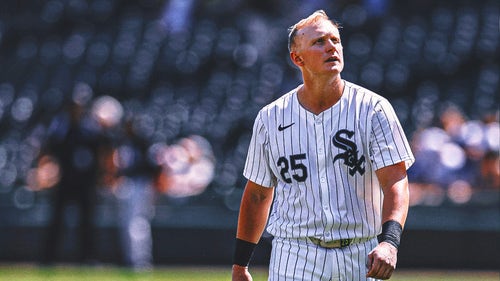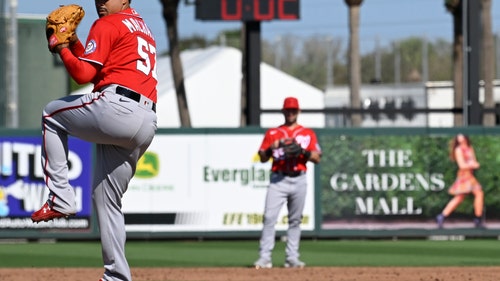
Yankees superstar Aaron Judge's three key rules of hitting
By Jake Mintz
FOX Sports MLB Writer
You know the deal already: Dude the size of Everest, plays for the most famous team, exceedingly good at baseball, hits a lot of home runs, etc.
The deadened baseball has had no discernable impact on Aaron Judge, who has 21 homers in 52 games and is on pace for 63 this season.
The Detroit Tigers, through Monday, have 30 homers as a team.
While Judge’s physique is often the first thing discussed about his offensive game — and with good reason, I mean, he’s 6-foot-7 and 280-plus pounds — his swing is much more than "haha big guy go brrrr." Many enormous power hitters have flashed bright and brief, struggling to make enough contact to capitalize on their impressive juice.
Judge’s ability to actually hit the darn baseball at a league-average rate while also hitting the ball harder than anyone else on the planet is a testament to his absurd athleticism, yes, but also to his attention to detail.
To dig deeper into the mind of the AL MVP front-runner, FOX Sports asked Judge to share his three main commandments of hitting.
For more, check out the three hitting commandments from Austin Riley and Francisco Lindor.
1. Coil the back hip
Before I could even ask a question, Judge already had "back hip" on his brain. It’s far and away the most important component to his swing.
"That’s where the magic happens," he said.
Those uninitiated with hitting mechanics might not consider the lower half to be crucial — you hit the ball with your arms, after all — but for Judge and many other hitters, the lower half, specifically the hips, is the key to rotating on time and with force.
"It’s all about being coiled, being coiled around my hip," Judge said. "They could just cut off my first leg. That’s how I think about it. If I just had one leg, I could still hit."
The concept of "coiling" or "hip coil" is a hitting movement that happens during the load phase, in which the hitter squats down slightly into his back leg while rotating on that leg slightly toward the catcher. It allows a hitter to then fire forward, rotating powerfully toward the baseball, similar to a coiled spring. It’s a subtle movement, so subtle that it’s difficult to pick up in full speed, but almost every elite big-league power hitter does it, whether he thinks about it or not.
2. Control the load
While Judge’s coil is crucial, he also recognizes that it’s pointless if not synced up correctly. Many hitters have a tendency to over-coil, which leads to a ton of head movement that makes it much more difficult to track the baseball.
"Once I get the coil in my hip," Judge told FOX Sports, "now it's about controlling that move forward and kind of hovering there. If I can kind of hover and pause as I'm just waiting for the ball, then I feel like I'm in a good position to hit."
Watch this slow-motion, open-side footage of Judge, and you can see the pause he’s talking about.
There’s so much movement happening before he uncoils from his hip. Notice how Judge’s front leg lifts and lowers, his SCAP muscle loads with his hands pulling back, and he sits down onto his back hip, all while his head stays perfectly still and balanced over his rear hip. That’s what he means by controlling the load.
"I've heard David Ortiz talk about this a lot," Judge said. "There’s this clip I have saved on my phone where he’s talking with Alex Rodriguez, and he talks about thinking like he has a rod running from his head down through his hip and all the way to his feet through his back leg."
Staying balanced and steady milliseconds before turning and firing with incredibly violent force toward the ball is a supremely difficult thing to do. That’s why so many hitters who swing hard and hit the ball hard strike out so often. Force equals movement, and that equals eye movement, which makes contact more difficult.
So while Judge still runs a pretty high strikeout rate, he’s able to stay balanced and hover in his pause often enough to, you know, lead the league in homers and stay on pace to set a Yankees single-season record.
3. Yes, yes, yes, no
This is a concept you’ll hear all the way down to Little League. Veteran big-leaguer Nick Castellanos once described it to me as controlled aggression. The idea is that on every single pitch, a hitter should be thinking about doing damage, about crushing the baseball. Any ounce of pre-pitch passiveness will lead to a hesitant swing and limit impact.
That’s how Judge thinks about it, too.
"I’m on every single pitch. It doesn't matter if it's a 3-0 count, the first pitch of the game, full count bottom nine. I'm thinking about swinging at every pitch until my eyes tell me not to. If I'm up there just trying to watch the ball, I'm gonna be in a bad place."
Judge likens the sensation to bow-hunting: If you aren’t fully invested when drawing back your arrow, you’ll have a more timid approach when your target presents itself. Staying at full intensity and maintaining intent on every single pitch is outrageously difficult, but it’s part of what makes a big-league mentality so different.
Aaron Judge is large, yes. He’s a hilariously athletic dude, yes. But he also has an approach to hitting that enables him to make the most of his natural ability.
Jake Mintz is the louder half of @CespedesBBQ and a baseball writer for FOX Sports. He’s an Orioles fan living in New York City, and thus, he leads a lonely existence most Octobers. If he’s not watching baseball, he’s almost certainly riding his bike. You can follow him on Twitter at @Jake_Mintz.






